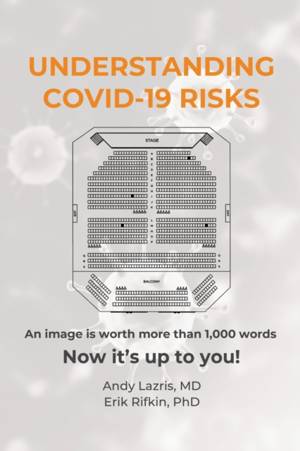
Door een staking bij bpost kan je online bestelling op dit moment iets langer onderweg zijn dan voorzien. Dringend iets nodig? Onze winkels ontvangen jou met open armen!
- Afhalen na 1 uur in een winkel met voorraad
- Gratis thuislevering in België vanaf € 30
- Ruim aanbod met 7 miljoen producten
Door een staking bij bpost kan je online bestelling op dit moment iets langer onderweg zijn dan voorzien. Dringend iets nodig? Onze winkels ontvangen jou met open armen!
- Afhalen na 1 uur in een winkel met voorraad
- Gratis thuislevering in België vanaf € 30
- Ruim aanbod met 7 miljoen producten
Zoeken
Understanding COVID-19 Risks
An image is worth more than 1,000 words
Erik Rifkin, Andy Lazris
Paperback | Engels
€ 20,95
+ 41 punten
Omschrijving
"The authors have presented a unique method of employing simple graphics, rather than pie charts or line graphs, or a slew of statistical data, to present an in-depth analysis of medical treatment. In simple language, they have demonstrated how their Benefit-Risk Characterization Theatre (BRCT), which is a 1,000-seater theatre, the benefits and risks of any medical intervention can be clearly displayed in a simple manner. Policy makers as well the general population can benefit from this simple, easy-to-understand tool. This will be especially useful in the current times when the entire world is struggling with the COVID-19 pandemic and no one really knows for sure how to tackle the situation." -Editor Review In this book, the authors utilize BRCTs to show what we know and what we don't know about COVID-19 using a system that can be applied to many health situations. We show that often, when statistics are placed in an accurate and easy to understand graphic, and they are individualized, then people and society can make choices about who is at risk and how to best mitigate and resolve that risk. Many aspects of COVID-19 communication were confusing and often inaccurate, and by putting them in a BRCT format we can slice through the misinformation and the muddied communication. For instance: - Do we know if school closings work?
- Are we protecting the elderly?
- What are the benefits and harms of a quarantine?
- Do we know whether masks work? These are some of many questions the authors attempt to answer in this concise and easy to understand book. The lessons of COVID communication can be applied to many other health outcomes, as the authors have done in their previous book published by Springer, Interpreting Health Benefits and Risks. A more comprehensive Springer book on COVID Communication has been written by the authors for those who seek a broader look at these issues. All references and documentation are in that book. This book is designed for the general public. The authors are experts in communicating medical information. Through their simple graphic they hope to help the reader become an expert as well.
- Are we protecting the elderly?
- What are the benefits and harms of a quarantine?
- Do we know whether masks work? These are some of many questions the authors attempt to answer in this concise and easy to understand book. The lessons of COVID communication can be applied to many other health outcomes, as the authors have done in their previous book published by Springer, Interpreting Health Benefits and Risks. A more comprehensive Springer book on COVID Communication has been written by the authors for those who seek a broader look at these issues. All references and documentation are in that book. This book is designed for the general public. The authors are experts in communicating medical information. Through their simple graphic they hope to help the reader become an expert as well.
Specificaties
Betrokkenen
- Auteur(s):
- Uitgeverij:
Inhoud
- Aantal bladzijden:
- 130
- Taal:
- Engels
Eigenschappen
- Productcode (EAN):
- 9798534599961
- Verschijningsdatum:
- 10/07/2021
- Uitvoering:
- Paperback
- Formaat:
- Trade paperback (VS)
- Afmetingen:
- 152 mm x 229 mm
- Gewicht:
- 181 g

Alleen bij Standaard Boekhandel
+ 41 punten op je klantenkaart van Standaard Boekhandel
Beoordelingen
We publiceren alleen reviews die voldoen aan de voorwaarden voor reviews. Bekijk onze voorwaarden voor reviews.











